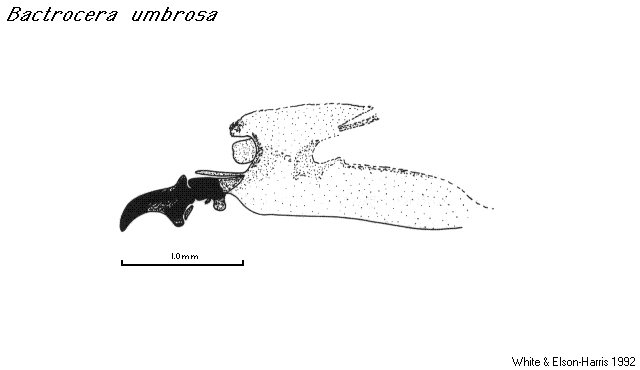Bactrocera umbrosa
Description
Typical of Bactrocera larvae with the following specific characteristics for the third instar:
General. Body length 8–11mm; Integument sometimes partially sclerotized; sclerotization forming a small heart-shaped patch of pigment below cuticle surface on ventral side of T1 (mature larvae); sclerotized process(es) on caudal segment absent.
Head. Stomal organ: number of peg sensilla three (small); peg sensilla with few short branches; other peg-sensilla-like structures absent. Stomal region: secondary lobes short, leaf-like (5 preoral lobes with the anterior lobe very large, forming a single lobe above the mandible); margins of secondary lobes all entire. Number of oral ridges 16–21; margins serrate (very short, broad, blunt teeth). Accessory plates small, shell shaped; margins unserrated, or serrated (with very few serrations). Median oral lobe absent or not protruding.
Spinules and creeping welts. Dorsal spinules on segments T1-T3.
Anterior spiracles. Anterior spiracular tubules 17–21.
Caudal segment (a8) and anal lobes. Anal lobes plainly visible, but not protuberant; simple.
Posterior spiracles. Slits 3.5x longer than wide (about). Dorsal spiracular processes with numerous trunks arising from a short or semicircular base (medium processes).
Host plants
| Family | Genus |
| Cucurbitaceae | Momordica |
| Moraceae | Artocarpus |
Part of plant attacked: fruit.
Biogeographic region and distribution
Australasian, Orientalw. Malaysia and Philippines to Vanuatu and New Caledonia; Micronesia.
Adult taxonomy
Bactrocera (Bactrocera) umbrosa (Fabricius)Dacus umbrosus Fabricius 1805: 274.—Indonesia. Sumatra. LT A UZMC. Lectotype designation by inference of holotype by Hardy 1973: 52; type data (Zimsen 1964: 484).
Dacus fascipennis Wiedemann 1819: 28.—Indonesia. Java. LT♂ NMW. Lectotype designation by inference of holotype by Hardy 1968: 146.
Bactrocera fasciatipennis Doleschall 1856: 412.—Indonesia. Javam [Java]. ST A NMW? Type data (Bezzi 1913: 71).
Strumeta conformis Walker 1856: 34.—Singapore. LT ♀ BMNH. Lectotype designation by inference of holotype by Hardy 1959: 167.
Dacus diffusus Walker 1860: 153.—Indonesia. Sulawesi: near Makassar [Ujung Padang]. T ♀ BMNH. Lectotype designated by Hardy 1959: 169 invalid, wrong sex (see Drew 1989: 165).
Dacus frenchi Froggatt 1909: 92.—New Caledonia. HT ♀ NSWA?
References
Carroll, L. E., A. L. Norrbom, M. J. Dallwitz, and F. C. Thompson. 2004 onwards. Pest fruit flies of the world – larvae. Version: 8th December 2006. http://delta-intkey.com.
Rohani, I. 1987. Identification of larvae of common fruit fly pest species in West Malaysia. Journal of Plant Protection in the Tropics 4: 135-137.
White, I. M., and M. M. Elson-Harris. 1992. Fruit flies of economic significance: their identification and bionomics. CAB International; Wallingford, UK. 601 p.



